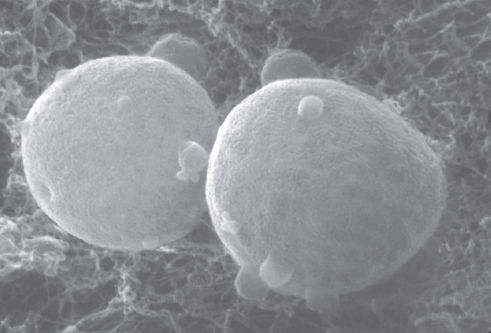
Chapter 3
Life’s Extremists: An Introduction to Archaea
Section 2
Life’s Extremists: An Introduction to Archaea
The domain Archaea was not recognized as a major domain of life until quite recently. Biologists distinguished between prokaryotic bacteria and the four eukaryotic kingdoms. The distinction recognizes the common traits shared by eukaryotic organisms, such as a true nucleus, a cytoskeleton, and various internal membranes. The scientific community was shocked in the late 1970s by the discovery of an entirely new group of organisms—the Archaea. Dr. Carl Woese and his colleagues were studying relationships among prokaryotes using DNA sequences, and found there were two distinct groups. Those “bacteria” living at high temperatures or producing methane clustered together as a group well away from the usual bacteria and eukaryotes. Because of this vast difference in genetic makeup, Woese proposed that life be divided into three domains: Eukaryota, Eubacteria, and Archaebacteria. The term was later simplified to Archaea because microbiologists wanted to distinguish this group from “true” bacteria.
The three domains shown below illustrate each group’s different cell traits. To the molecular biologist, cells from Bacteria, Archaea, and Eukarya are vastly different, having distinct biochemical make-ups. It is true that most archaeans look similar to bacteria under the microscope, and that the extreme conditions under which many species live has made them difficult to culture. For years, their unique place among living organisms went unrecognized. However, their rRNA sequences (coding for various proteins) are distinct from bacteria. For example, near nucleotide 910 (out of 1,500), this difference in RNA sequence has been found:
Bacteria AAACUCAAA
Archaea AAACUUAAAG

The sequences of Archaea are more similar to Eukaryotes than to bacteria. Early classification of bacteria depended on individual shapes, the appearance of colonies in laboratory cultures, and other physical characteristics. The classification of bacteria underwent changes in the 1980s, when it became possible to sequence their DNA rapidly. The nomenclature shift came because Archaea are not bacteria in the traditional sense. Their cell walls do not contain peptidoglycan, their cell membranes have unusual lipid composition, and the RNA in their ribosomes has a unique chemical composition. Because ribosomes are so critically important in the functioning of living things, Darwinists feel they are not prone to rapid evolution. A major change in ribosome sequence can render the ribosome unable to fulfill its duties of building new proteins for the cell. Because of this, evolutionists say the sequence in the ribosomes is conserved—not changing much over time. By comparing the slight differences in ribosome sequence among a wide diversity of bacteria, groups of similar sequences were found, then recognized as a related group by secular microbiologists.
Another reason for separating Archaea from other prokaryotes is the extremely harsh environments in which many species live. Archaeans include inhabitants of some of the most extreme environments on the planet. Indeed, the new word extremophiles has been coined for organisms like these. One group is the thermoacidophiles, which live under extremely acidic, hot conditions, including near rift vents in the deep sea at temperatures well over 100°C (212ºF). Others live in hot springs, or in extremely alkaline or acidic waters. Still other Archaea have been found inside the digestive tracts of cows, termites, and marine life, producing methane and referred to as methanogens. These live solely on carbon dioxide, nitrogen, and water, and are found in the anoxic mud of marshes, at the bottom of the ocean, and even in petroleum deposits deep underground. Another group of Archaea can survive the desiccating effects of extremely saline waters, such as Utah’s Great Salt Lake and ponds near San Francisco Bay. One salt-loving group of Archaea includes Halobacterium, a well-studied Archaean (see below). These are called extreme halophiles. It’s interesting to note that the red light-sensitive pigment giving Halobacterium its color, a simple photosynthetic system providing Halobacterium with chemical energy, is known as halorhodopsin and is chemically similar to rhodopsin, the light-detecting pigment found in vertebrate retina. This is a case of parallel design by the Creator.
Archaeans may be the only organisms that can live in extreme habitats like thermal vents or hypersaline water. They may be extremely abundant in environments hostile to all other life forms. Many secular biologists speculate that Archaea represent the oldest life forms; they postulate that early earth conditions were harsh when life first started to evolve. However, Archaea life forms are not restricted to extreme environments. New research shows Archaeans to be quite abundant in the plankton of the open sea. These findings suggest Archaea are just variations of the Creator’s plan for bacteria-like life forms, created at the same time as “typical” bacteria, fungi, and other microbial life forms. There is still much to be learned about these microbes, but it is clear that the Archaea are a remarkably diverse, successful group of microbes.
Creation Focus 3.2
Yellowstone’s Hidden Biological Resources
For over 100 years, the large populations of big animals like elk, moose, buffalo, and bear have fascinated visitors to Yellowstone National Park. However, these beautiful animals represent only a tiny fraction of its significant biological resources. Visitors might be surprised to learn that the living organisms in Yellowstone with the greatest economic impact on society are quite invisible. These are the microorganisms living in the boiling waters and runoff channels of the geysers and hot springs. Though their color is visible to the naked eye, individual microbial cells are completely invisible. It is only because of their vast numbers that we know they are there. The microorganisms of the hot springs are mostly bacteria, but at lower temperatures, algae and protozoa are also present. Why are these tiny creatures of Yellowstone’s hidden depths so important? Since their discovery in the 1960s, they have been found to have major uses in the biotechnology industry. The most important discovery was the Taq polymerase, an enzyme used in PCR (see chapter 19), isolated from a hot spring bacterium called Thermus aquaticus. Because these unique bacteria can survive such hot temperatures, their enzymes work extremely fast, therefore greatly accelerating other biochemical reactions in the wild or in the laboratory. Yellowstone has been a wonderful resource for researchers from biotechnology companies worldwide looking for new kinds of bacteria to be used commercially.
The Creator’s Watercolor Mosaic at Yellowstone
Although Yellowstone is famous for its geysers, the beautiful colors associated with them are often a surprise. One sees hot water flowing over patches of brilliant yellow, orange, red, and green; hot pools lined with color; and even steam appearing to be colored. The geologists who mapped the thermal basins in the late 1800s recognized that the colorful deposits were microbial. The presence of living creatures in water too hot to touch is amazing. But even more impressive is that these organisms are not only living, but also thriving. In fact, they are so perfectly adapted to their environments that they can live nowhere else. Such organisms, called thermophiles, are found in hot environments worldwide—not only in hot springs but also in volcanoes, deserts, and man-made thermal environments like power plants and hot-water heaters. But nowhere else are they in such obvious, brilliant profusion as at Yellowstone.
Many living organisms and their parts can best be visualized as mosaic patterns. Mosaics in nature mirror artwork. The architectural designs of Escher represent a mosaic, blending mathematical principles with artistic vision. Likewise, biological mosaic patterns show contrasts between colors, pigments, and structures. Biological mosaics are most readily seen in cell pigments. Like a master painter splashing colors to paint a sunset, we see equally beautiful colors at Yellowstone and in other features. What causes these colors? In Grand Prismatic spring, and others of similar character, the orange color is due to pigmented bacteria of microbial mats, and the blue color to refracted skylight. The principal pigment for photosynthesis is chlorophyll, which is green. However, chlorophyll is sometimes masked by carotenoids, pigments related to vitamin A, and which are orange, yellow, or red. Carotenoids protect the cells from the bright sunlight occurring at Yellowstone, especially during the summer.
The color of a mat depends principally upon the ratio of chlorophyll to carotenoids. In the summer, the chlorophyll content is often low, so the microbial mats appear orange, red, or yellow. In the winter, the mats are usually dark green, because then the sunlight is subdued, and chlorophyll dominates over carotenoids. In fact, even a few cloudy days in mid-summer can lead to an increase in chlorophyll and a darkening of the mats. Thus, it is not only the kinds of bacteria but also their response to sunlight that determines the colors.
Temperature is one of the most important environmental factors, and organisms differ strikingly in their ability to adapt to high temperatures. Biologists recognize three major categories of living organisms: Eukarya, Archaea, and Bacteria. Complex organisms (plants and animals) are Eukarya, so called because their cells have true nuclei and undergo cell division by mitosis. We call these organisms eukaryotic. Archaea and Bacteria are much simpler, seldom occurring multicellularly, and lacking true nuclei and mitosis. They are called prokaryotic.
The upper temperature limits for bacteria are very high. Note that the eukaryotes are unable to adapt to high temperatures, their upper limit being about 60–62°C (140–144°F). The upper temperature limit for plants and animals is even lower—less than 50°C (122°F). Note that very few eukaryotes are able to adapt to these upper limits, the majority being restricted to much lower temperatures.
At temperatures above 60–62°C (140–144°F), the only organisms present are prokaryotes. Photosynthetic bacteria have upper temperature limits lower than in non-photosynthetic bacteria. The upper limit of photosynthetic bacteria is about 70–73°C (158–163°F). At higher temperatures, only non-photosynthetic bacteria can grow. At the highest temperatures, over 100°C (212°F), the only bacteria found are a few unusually heat-adapted Archaea called hyperthermophiles. Water boils in Yellowstone at about 92°C (198°F). These bacteria thrive in boiling water!

Scanning electron micrograph of Halobacterium mediternaei bacteria.
The Upper Temperature for Life
When microbiological researchers first began studying the Yellowstone hot springs in the 1960s, one of the biggest surprise discoveries was that prokaryotes were thriving even in boiling water. These prokaryotes were not obvious, such as the microbial mats, living attached to the rock-like walls of the springs or to pebbles. Sometimes their long, intertwined filaments accumulated on the bottom of the channels. Even if the source pool looks white and sterile, microscopic study usually reveals large numbers of prokaryotes. Such prokaryotes are found not only in Yellowstone, but also in hot springs worldwide, even in springs at lower altitudes where water boils at higher temperatures. It is amazing that, in addition to living in boiling water, these prokaryotes are growing surprisingly rapidly; a population can double in as little as two hours.
The presence of prokaryotes in boiling water (100°C, 212°F) makes us wonder if there is an upper temperature for life. Temperatures even hotter than 100°C occur in the thermal vents found on ocean floors. Because of the high pressure in ocean depths, temperatures of over 300°C (572°F) are found. Careful study has shown that at such high temperatures, no living organisms are present, but evidence exists of prokaryotes living at temperatures as high as 115°C (239°F). In fact, cultures have been obtained that can be easily grown at this temperature in the laboratory. Interestingly, 115°C (239°F) is near the temperature at which hospital sterilizers operate, yet here are prokaryotes that actually prefer such temperatures! Prokaryotes can grow over the complete range of temperatures in which life is known possible.
Thermophiles and Evolution
How is it possible for living organisms to survive at such temperature extremes? Actually, this only surprises us because of our anthropocentric orientation. Humans and other animals are very heat-sensitive, but the biological world is much more diverse than we realize. Life, especially prokaryotic life, is able to adapt to environmental conditions deadly to humans.
In fact, many Darwinists believe that life as we know it might first have arisen three billion or so years ago in high-temperature environments, and that the first organisms on earth might therefore have been thermophiles. Such thermophiles would then have continued to exist in the intervening period, finding refuge in the hot springs continuing to dot the earth. In addition, these thermophiles would have been the forerunners of all other life forms, including, eventually, humans.
The Genesis of Germs
Professor Alan Gillen shows that constantly mutating diseases are proof for devolution rather than evolution.
Read OnlineRecommended Resources

Answers in Genesis is an apologetics ministry, dedicated to helping Christians defend their faith and proclaim the good news of Jesus Christ.
- Customer Service 800.778.3390
- © 2024 Answers in Genesis


